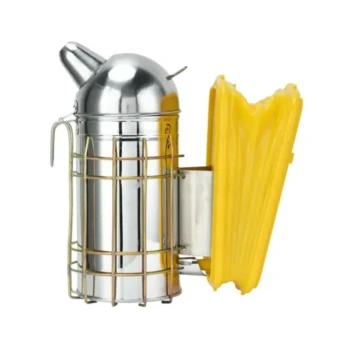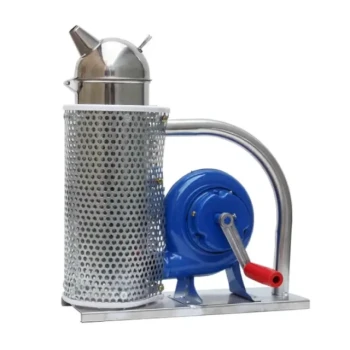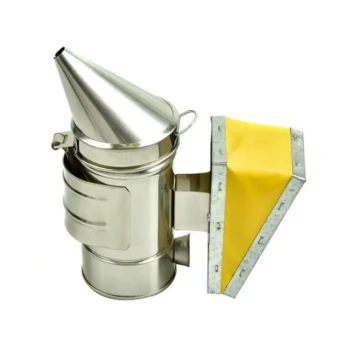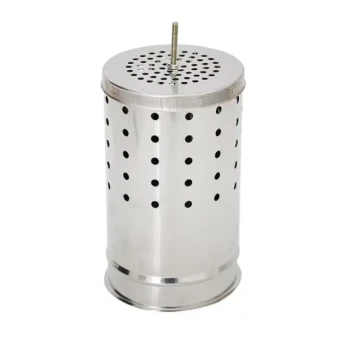At its core, a bee smoker is a tool that pacifies a honey bee colony to make it manageable and safe to inspect. Its primary benefits are to dramatically reduce bee aggression and protect the beekeeper from stings, which in turn allows for more effective and less stressful hive management for both the beekeeper and the bees themselves.
A bee smoker works by tapping into the bees' evolutionary instincts. The smoke masks alarm signals and triggers a false fire alarm, causing the bees to focus on consuming honey rather than defending the hive, making them significantly calmer and less likely to sting.
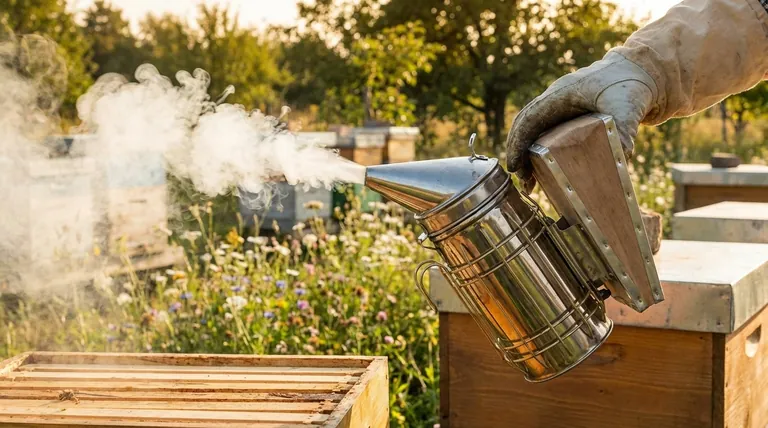
How Smoke Fundamentally Changes Bee Behavior
To understand the smoker's benefits, you must first understand the two ways it alters bee psychology and physiology. It is not simply a repellent; it's a communication tool that redirects the colony's priorities.
It Triggers a "False Alarm" for Fire
Smoke is a powerful, ancient signal of danger to a honey bee colony. In nature, the smell of smoke means a forest fire is approaching, threatening to destroy their home and food stores.
This signal overrides their immediate defensive instincts. Their top priority shifts from guarding the hive against an intruder to preparing for a potential evacuation.
It Encourages Honey Consumption
In response to the perceived fire threat, bees rush to their honey stores and begin to gorge themselves. This is a survival mechanism to load up on as much energy (honey) as possible in case they are forced to abandon the hive and build a new one elsewhere.
A bee with a full stomach of honey is physically less able to flex its abdomen to sting. This engorged, docile state is often called being "well-fed and happy," but it is more accurately a distracted state of emergency preparedness.
It Masks Critical Alarm Pheromones
When a bee stings, it releases an alarm pheromone into the air. This chemical signal instantly alerts other guard bees to the threat, inciting them to attack the same target and creating a dangerous defensive chain reaction.
Smoke effectively scrambles this communication channel. The strong scent of the smoke particles masks the alarm pheromone, preventing other bees from detecting the signal and joining the attack. This is why smoking the area immediately after a sting can prevent further incidents.
The Practical Benefits for the Beekeeper
By altering the bees' behavior, the smoker provides direct, tangible benefits that make beekeeping a safer and more successful practice.
Safer and More Confident Inspections
Knowing you have a tool that can reliably calm the hive allows you to work with more confidence and less apprehension. A calm beekeeper moves slowly and deliberately, which is less likely to startle the bees or accidentally crush them.
Reduced Stings and Bee Fatalities
The most obvious benefit is a dramatic reduction in stings. This not only protects the beekeeper but also saves the bees' lives. When a honey bee stings a mammal, its barbed stinger becomes lodged in the skin, and it dies shortly after.
By preventing stings, the smoker is a critical tool for bee welfare.
More Efficient Hive Management
A docile colony allows you to perform essential tasks—like checking for the queen, inspecting for disease, or harvesting honey—more thoroughly and efficiently. You can complete your work without constantly fighting off defensive bees, ensuring the inspection causes minimal disruption to the colony's routine.
Using the Smoker Correctly: Technique Matters
The benefits of a smoker are only realized when it is used properly. Improper use can be ineffective at best and harmful at worst.
The "Less is More" Principle
A common mistake is using far too much smoke. A few gentle puffs at the hive entrance before opening, and a few more across the top of the frames, is usually sufficient.
Only apply more smoke if the bees begin to show signs of aggression. Over-smoking can agitate the colony and is unnecessarily disruptive.
Proper Fuel and Temperature
Use a quality, clean-burning fuel like pine needles, burlap, or commercial smoker fuel. Your goal is to produce thick, cool, white smoke.
Always test the smoke's temperature on the back of your hand before puffing it toward the bees. Pumping the bellows too aggressively can shoot out hot embers or flames, which can burn the bees' delicate wings.
The Right Timing and Approach
Announce your presence by puffing smoke near the hive entrance 30-60 seconds before you open the lid. This gives the bees time to react and begin consuming honey.
Work calmly and gently. The smoker is a partner to your calm demeanor, not a replacement for it.
Applying This to Your Beekeeping Practice
The smoker is not just an accessory; it is a foundational piece of equipment that enables responsible beekeeping.
- If your primary focus is personal safety: The smoker is your most crucial tool for preventing stings by disrupting the bees' defensive communication and instincts.
- If your primary focus is bee welfare: Proper smoke usage prevents defensive chain reactions, which directly reduces bee fatalities and allows for calm, less disruptive hive inspections.
- If your primary focus is efficiency: A calm hive allows you to complete essential health checks and maintenance tasks faster and more thoroughly, leading to a healthier and more productive colony.
Ultimately, mastering the bee smoker is about learning to communicate with your bees in a language they understand, fostering a relationship built on respect rather than force.
Summary Table:
| Key Benefit | How It Works | Result for the Beekeeper |
|---|---|---|
| Reduces Bee Aggression | Smoke triggers a 'false fire alarm,' causing bees to gorge on honey instead of defending the hive. | Safer, more confident hive inspections with minimal stings. |
| Prevents Chain-Reaction Stings | Masks alarm pheromones released by guard bees, stopping other bees from joining an attack. | Protects both the beekeeper and the bees, reducing fatalities. |
| Enables Efficient Hive Management | A calm colony allows for thorough checks for the queen, disease, and honey production. | Faster, more effective hive maintenance and healthier colonies. |
Ready to enhance your apiary's safety and efficiency? HONESTBEE supplies professional-grade bee smokers and beekeeping equipment to commercial apiaries and distributors. Our wholesale-focused operations ensure you get reliable, durable tools that protect your investment and your bees. Contact us today to discuss your needs and discover how our equipment can support your beekeeping success. Get in touch now!
Visual Guide
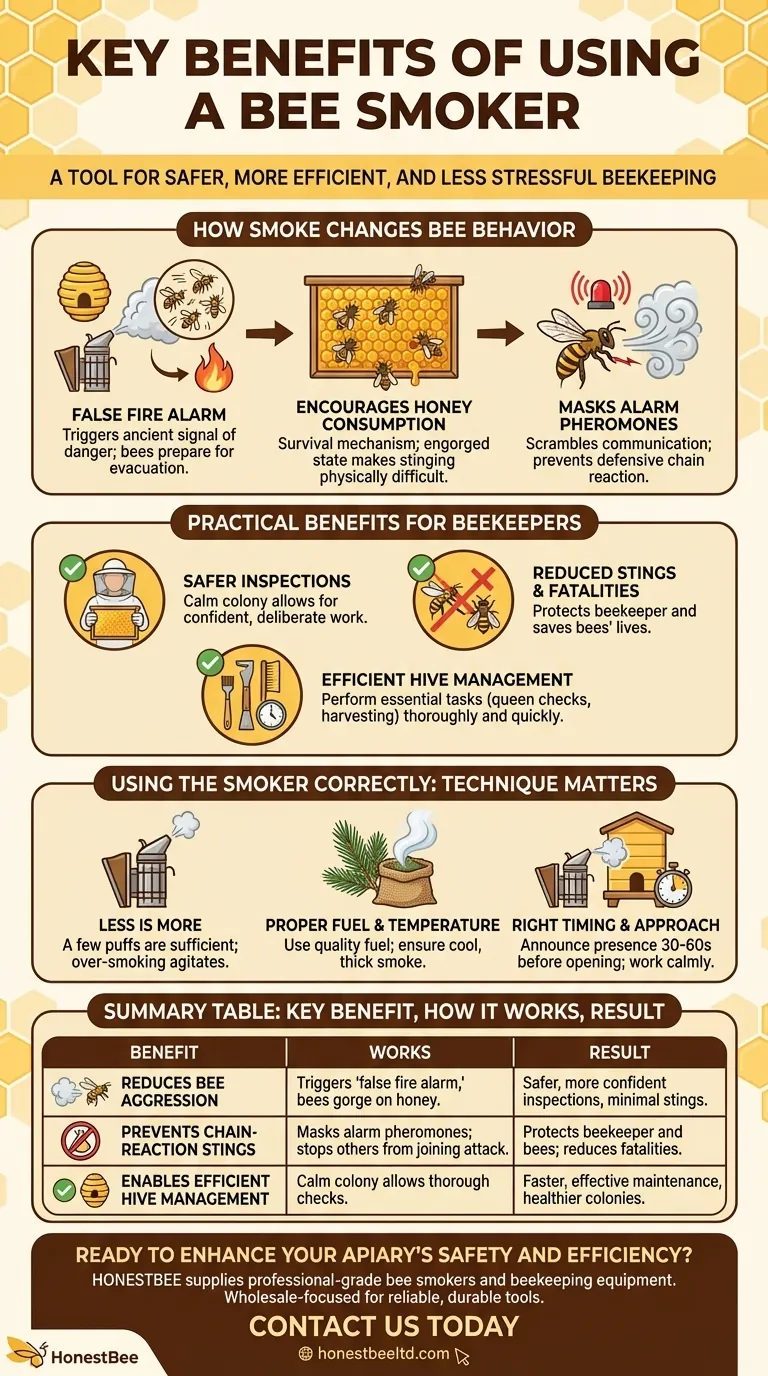
Related Products
- European Stainless Steel Bee Smoker for Honey Bee Hive
- Premium Traditional Copper Bee Smoker with Bellows
- Professional Bee Smoker with Elongated Spout and Durable Bellows for Beekeeping
- Heavy-Duty Bee Smoker with Durable Plastic Bellows for Beekeeping
- Heavy Duty Manual Bee Smoker Blower for Beekeeping
People Also Ask
- What are the features of a recommended bee smoker? A Guide to Safety, Durability & Performance
- Can you use too much smoke on bees? The Right Way to Use a Bee Smoker for Calm Inspections
- What factors should be considered when choosing a bee smoker? Find the Right Tool for Safe, Effective Hive Management
- What are the advantages of a high-quality bee smoker? Achieve Calm, Confident Hive Management
- What are the differences between stainless steel and galvanized steel bee smokers? Choose the Right Smoker for Your Apiary



